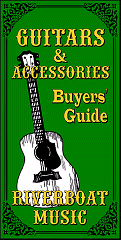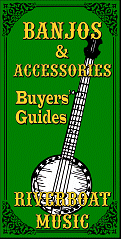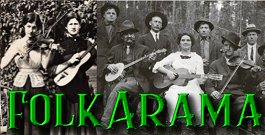
PART 3 - G, the D Chord's Other Best Friend
| Please Read: How to Help Our Site at No Cost to You - Some of our articles contain recommendations for products we like and vendors we personally trust. Some of those vendors may pay us a very small commission if you click on a link and buy their products. This costs you nothing at all and helps offset the costs of what we do. So if we point you to something you decide to buy later, please make certain you come back through our site and click on the link directly. Thanks. |
| This Site is a Cookie-Free Zone - Except for discussion forums that you have to expressly register for, none of our pages use cookies of any kind. Some of the vendors we link to do, but that won't affect you unless you click on a link to their pages. Your continued use of this page indicates that you agree to our policy. For details, click here. |



|


3 Magic Cords, Part 3: G, the D Chord's Other Best Friend
This is a follow up to "3 Magic Chords, Part 2," which encourages you to learn switching back and forth between two easy chords. In this lesson, you should learn the third most important chord in the key of D - one which, you will see later, is important in its own right as well.
This series, in turn, is part of the "VERY Basic Guitar subset of our "How To Folk" articles. In an effort to "jump start" your enjoyment of Folk music and your ability to join in, no matter what instrument you play, we are providing some very basic notes about guitar chords.

 Note: - This part of the Folkarama page, which is dedicated to helping beginners "get into" Folk music and join Folk communities as easily as possible, with simple articles and links to resources that provide hands-on instruction in traditional acoustic instruments.
Note: - This part of the Folkarama page, which is dedicated to helping beginners "get into" Folk music and join Folk communities as easily as possible, with simple articles and links to resources that provide hands-on instruction in traditional acoustic instruments.
Folkarama, in turn, contains many references to more extensive articles and resources in Paul Race's CreekDontRise.com site, as well as other related pages.
 G, the D Chord's Other Best Friend
G, the D Chord's Other Best Friend
Why do you need to know more than two chords? Because there are literally over a million songs that can be sung with three chords.
And if you're singing in the key of D, the third most important chord is G. In fact, it's so important that musicians call it the "Subdominant" chord of D. (Remember, A7 already claimed the term "Dominant.")
In case you wondered, most chords have names, depending on how they relate to the key of the song. The main chord is the "Tonic." The D chord has been our tonic throughout the lessons so far.
Back to the G chord, to go from D to G, you:
- Move your ring finger from the second string to the first string, keeping it just behind the third fret.
- Move your forefinger to the fifth string, keeping it just behind the second fret.
- Move your middle finger to the sixth string, but put it just behind the third fret.
Going back and forth between D and G isn't as easy as going back and forth between G and A7, but every person who is playing guitar today buckled down and practiced until it was second nature.
 'Nudder G Chord
'Nudder G Chord
Lots of folks today are using a version of the G chord that I only started using relatively "late in life." It is still a G chord, but:
- Some folks think it's easier to get back and forth to D, because your ring finger stays in the same place.
- It makes it easier to play songs in G (because it let's you "cheat" on the C chord, which we'll talk about later.
- It has a more open, less rich sound than the standard G chord above. It's almost what they call an "open fifth," which is popular in certain Folk and Celtic styles.
If you're playing in D, either version works well for most songs.
To go from D to this version of G, you:
- Keep your ring finger right where it is.
- Put your pinky next to it on the first string, keeping it just behind the third fret.
- Move your forefinger to the fifth string, keeping it just behind the second fret.
- Move your middle finger to the sixth string, but put it just behind the third fret.
Try both ways of playing G and see which one works the best for you if you're playing songs in D. And when you notice someone playing the G chord the other way, be nice, but be glad you found a way that works for you.
One-Chord Songs You Can Play in G - One you can play in G only is "Amazing Grace." Yes, most people use more chords, and you will, too, eventually. But in many old hymnbooks, it never departs from the G chord. Of course, you can always play "Farmer in the Dell," "Frere Jaques,"and "Row, Row, Row Your Boat" with just the G chord as well.
Two-Chord Songs You Can Play in G - To practice going back and forth between G and D7, you can try playing the songs we've already mentioned trying with D and A7, "Buffalo Gals," "'Tis the Gift to be Simple," "Go Tell Aunt Rhody," "Down in the Valley," "Down at the Station," "Tom Dooley," and "He's Got the Whole World in His Hands."
 Learning D7 - We're sneaking one more chord in here: D7. This is the version of D that most people use when they're playing in the key of G (the same way most people use A7 when they're playing in the key of D). Why? Because the extra "flatted seventh" note that gives chords like A7 and D7 their name adds a little extra "tension" that signals to the listener that the song is going to come back to the "tonic." In a sense A7 "wants" to go to D. D7 "wants" to go to G.
Learning D7 - We're sneaking one more chord in here: D7. This is the version of D that most people use when they're playing in the key of G (the same way most people use A7 when they're playing in the key of D). Why? Because the extra "flatted seventh" note that gives chords like A7 and D7 their name adds a little extra "tension" that signals to the listener that the song is going to come back to the "tonic." In a sense A7 "wants" to go to D. D7 "wants" to go to G.
That said, if a D7 is written and it's easier to play a D cord in that section, nobody will notice. (You're just leaving one note out, not changing anything else, and most people won't notice the absence.)
Why Play Songs in Different Keys? - You may find that some of these songs are easier to sing in G than D, or vice versa. For example, "Buffalo Gals" is out of my comfortable vocal range when I sing it in G. That's one reason Folk and Country singers learn to play in more than one key. (Bluegrass singers don't seem to care if a song is out of their range; in fact they may prefer it.)
 Songs that Use D, G, and A7 - One easy song to play with three chords is "Crawdad." We're giving you an MP3 file and sheet music to help you get a sense of where the chords change.
Songs that Use D, G, and A7 - One easy song to play with three chords is "Crawdad." We're giving you an MP3 file and sheet music to help you get a sense of where the chords change.
- To hear an instrumental version, click here.
- To download a lead sheet (showing the melody and chords), click here.
There are hundreds of other 3-chord Folk songs that you can play in the key of D (using D, A7, and G) include: "Sloop John B," "Will the Circle Be Unbroken," "Home on the Range," "You Are my Sunshine," "Down By the Riverside," and "When the Saints Go Marching In."
Countless pop songs use just three chords as well.
The only limit to playing any three-chord song in the key of D is that the melody might be too high or too low for you to sing comfortably. That's one reason we will set you up to play three chord songs in G next. G is a favorite key of Folk and Country musicians, and the favorite key of Bluegrass banjo players.
Where's the Magic?
Okay, I promised you magic, and all I've given you so far is a bunch of hard work.What beginners don't realize at first is just how many songs - millions, literally - you can play with just three chords. We have listed a few more here:
Conclusion
These suggestions are just a start, of course. But for all of its variations and even contradictions, Folk music is a discipline in itself, and a rewarding one of that. The more you play, sing, practice, and hang, the more you'll get out of it, the faster you'll learn in the future, and the better you'll be at whatever you already do have "under your belt."Other Resources
There are plenty of guitar instruction materials, online, of course. But we are working on a few that will help you learn the most basic, but necessary, information quickly.The current resources we have published are:
- Meet Your Guitar - a very basic intro to holding, tuning, and picking the guitar.
- Three Magic Chords - a three-part series to introduce enough easy guitar chords to get you started on playing hundreds of 2- and 3-chord songs. Articles include::
- 3-Chord Songs in D - A list of songs you can easily play in D, using G and A7. (When you get a little farther along, you can also play many of them in E, using E, A, and B7. Or in C, using C, F, and G7. Yes, we will show you all of those chords eventually.)
- What is a Three-Chorder? - Explains "3-chorders," and how understanding them will help you learn or follow along on thousands of songs without sheet music or lead sheets.
- More Useful Chords - "Next steps" to expand your range and enable you to play even more songs, including:
- C and C9 Chords
- It's All Relative - Am and Em
- A Major - the Fiddler's Friend
- E Major, a Cornerstone of Blues and Folk
- F Major - Set your C Chord Free!
- 3-Chord Songs in G - A list of songs you can easily play in G using G, C9 (or C) and D7. (When you get a little farther along, you can also play many of them in A, using A, E7 and D.)
- About Capos - A necessary tool that can become a crutch if you rely on it too much.
Sister Sites
 Other sites we started to keep this site from getting too big to be useful include:
Other sites we started to keep this site from getting too big to be useful include:
- CreekDontRise.com is a repository of articles about Folk music and the instruments on which it has been traditionally played.
The "Acoustic" page includes a long list of articles including maintenance and playing tips on all sorts of traditional acoustic instruments.
 RiverboatMusic.com is a buyers' guide for acoustic and traditional instrument from a musician's point of view, focusing on the uses, reliability, and practicality of various instruments, and not just the marketing hype about the shape of the fret markers or whatever.
RiverboatMusic.com is a buyers' guide for acoustic and traditional instrument from a musician's point of view, focusing on the uses, reliability, and practicality of various instruments, and not just the marketing hype about the shape of the fret markers or whatever.
For instruments like dulcimers that have mostly small manufacturers or cheap imports, we try to tell you what to look for, irrespective of brand.
 Momma Don't 'Low includes a free e-mail newsletter that discusses all of those topics above and more. We plan to include other features as time permits.
Momma Don't 'Low includes a free e-mail newsletter that discusses all of those topics above and more. We plan to include other features as time permits.
Note - If you wish to sign up for our newsletter and ask a question at the same time, please click on the Momma Don't 'Low newsletter button to learn more and to get a link to our signup form.
 PaulRaceMusic.com is the "landing page" for Paul's own musical endeavors, plus many memoirs and blogs about music and the music business.
PaulRaceMusic.com is the "landing page" for Paul's own musical endeavors, plus many memoirs and blogs about music and the music business.
 ClassicTrainSongs.com describes railroad songs that every train lover should know. Or at least know about.
ClassicTrainSongs.com describes railroad songs that every train lover should know. Or at least know about.
- SchoolOfTheRock.com has articles about Christian music, Christian music careers and performance, Christian living in general, and vintage saxophones, another of Paul's interests. This site has separate newsletters, etc., by the way - there isn't a lot of overlap with the Momma Don't 'Low(tm) newsletters.
For information about other music collections and projects, check the links at the bottom of this page.
 Whatever else you get out of our pages, I hope you come away with some great ideas for "sharing the joy."
Whatever else you get out of our pages, I hope you come away with some great ideas for "sharing the joy."
And please stay in touch!
All material, illustrations, and content of this web site is copyrighted (c) 2001, 2002, 2003, 2004, 2005, 2006,
2007, 2008, 2009, 2010, 2011, 2012, 2013, 2014, 2015, 2016, 2017, 2018, 2019, 2020, 2021, 2022, 2023 by Paul D. Race. All rights reserved.
Creek Dont' RiseTM is a participant in the Amazon Services LLC Associates Program, an affiliate advertising
program designed to provide a means for sites to earn advertising fees by advertising and linking to Amazon.com.
For questions, comments, suggestions, trouble reports, etc. about this page or this site, please contact us.
| Visit related pages and affiliated sites: | |||||
| - Music - | |||||

|
 |
 |

|

|

|

|

|

|

|

|

|

|

|

|

|

|

|
| - Trains and Hobbies - | |||||
 |

|

|  |
 |

|
| - Christmas Memories and Collectibles - | |||||
 |

|
 |

|
 |

|
| - Family Activities and Crafts - | |||||
 |

|

|

|

|

|

